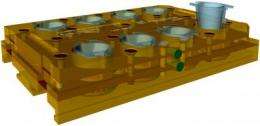How dangerous are air pollutants really?

How severely do smog, diesel exhaust and secondhand smoke damage the lungs? What do pollen or nanoparticles trigger when they infiltrate the human body through inhaling? At this year's BIO Convention in Chicago from May 3-6, Fraunhofer researchers will present a new test system that can be used to investigate these questions.
Through this system, it will be possible for the first time ever to channel substances from the air, under precisely controlled conditions, through the lung cells or skin cells, and simultaneously observe the reactions of these cells under the microscope.
The air brings a plethora of chemical substances into contact with our bodies. Precisely how the skin and mucous membranes or bronchi and lungs respond to the forced contact with foreign matter can best be studied in cell cultures that originate from the respective tissues. "What you do is cultivate cells onto a porous plastic membrane coated on the bottom with a culture medium, and then from above you conduct air with the test substance over the cells," explains Detlef Ritter of the Fraunhofer Institute for Toxicology and Experimental Medicine ITEM in Hannover, Germany.
Quite simple, theoretically speaking. But in practical terms, this test procedure - which had already conceived back in the 1970s - still poses problems today: "With the conventional test systems, the atmosphere above the cells frequently is not separated cleanly enough from the culture medium, especially along the margins of the membrane. That's why the test substances sometimes react directly with the solution instead of the cell surface - which adulterates the measurements," says Ritter. One other shortcoming of the systems currently available: If you want to study cells treated with air pollutants under the microscope, then you have to apply them to a new vessel beforehand - a step that likewise influences test results.
The new test system, developed at Fraunhofer's ITEM and submitted for patent, bridges these pitfalls: The PRIT® Air/Liquid Interface Culture and Exposure System consists of several components. The principle element is the culture plate, in the dimensions of commercially available multiwell plates. It has an added exposure attachment, gas feed line and hotplate. "The culture vessel is constructed in a manner that prevents contact between the inflowing gas - and thus the test substances carried in them as well - and the culture medium. The support membrane forms a closed barrier with the adherent cells between both media," explains Detlef Ritter. Moreover, this system allows researchers for the first time to precisely define and control all the important physical parameters - such as composition, temperature, pressure and flow velocity of air and culture medium. "That elevates the robustness, reproducibility and sensitivity of the tests," says the Fraunhofer researcher.
Another advantage of the PRIT® system: Researchers can observe the cells directly during contact with air pollutants. In addition, they can strain the tissue prior to the test with certain fluorescent dyes that indicate various growth processes, toxic and stress reactions or deleterious changes to genetic material, within the shortest period of time using powerful illumination. The fluorescent light penetrates through the transparent base of the culture plate outward, and can be recorded and evaluated with the microscope. Through this "live imaging," the effect of certain air pollutants on the tissue being studied can be evaluated without further disturbance or time delay.
Provided by Fraunhofer-Gesellschaft



















